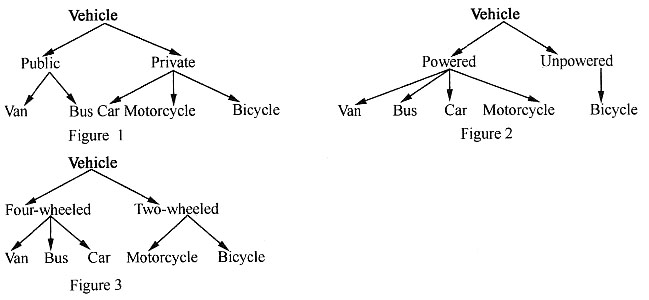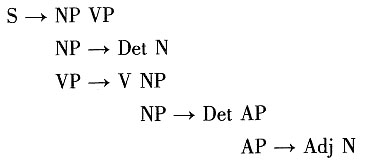ⅠBriefly answer the following questions.(注:本题为简答题,每题6分)1. What is a phoneme? How to discover phonemes?
Phoneme is a basic unit of phonological study, and it is an abstract collection of phonetic features which can distinguish meaning. By convention, phonemic transcription are placed between slant lines (//), like, / t / or / d/.
A phoneme is a phonological unit that is of distinctive value. It's the smallest distinctive unit in the sound system of a language. It's a unit of explicit sound contrast. If two sounds in a language make a contrast between two different words, they are said to be different phonemes.
2. What are endocentric and exocentric compounds? Which compounds below are endocentric and which are exocentric?
airplane; clog food; pickpocket; policeman; redhead; sky-blue; walkman.
Compounds can be further divided into two kinds: the endocentric compounds and the exocentric compounds. The head of a nominal or adjectival endocentric compound is de-verbal, that is, it is derived from a verb. Consequently, it is also called a verbal compound or a synthetic compound. Usually, the first member is a participant of the process verb. (e. g. self-control, pain-killer; bullet-resistant, sun-tanned.)
The exocentric nominal compounds are formed by V + N, V + Adv., and V + P, whereas the exocentric adjectives come from V + N and V + Adv. (e. g. playboy, sit-down, breakthrough; breakneck, walk-in.)
The endocentric compounds are airplane, dog food, redhead, sky-blue.
The exocentric compounds are pickpocket, policeman, walkman.
3. What are syntagmatic and paradigmatic relations? Explain each of them with an example.
Syntagmatic and paradigmatic relations follow from the distinction which Saussure makes between synchronic and diachronic perspectives. Syntagmatic relation refers to horizontal relations. It is a relation between one item and others in a sequence, or between elements which are all present, such as relation between "weather" and the other in the follow: If the weather is nice, I'll go out. If the words in a sentence fail to occur in the fixed order required by the convention of a language, the utterance would be ungrammatical or nonsensical. For example, "The boy kicked the ball" can not be replaced by "Boy the ball kicked".
Paradigmatic relation refers to the vertical relation. It is a relation holding between elements replaceable with each other at a particular place in a structure, or between one element present and the others absent. They can substitute for each other without violating syntactic rules. For example, "The strong man smiles" can be replaced by "The tallest boy smiles" or "The pretty girl smiles".
4. What is Contrastive Analysis (in Linguistics and Foreign Language Teaching)?
Contrastive Analysis (CA) came into fashion in the 1960s. It is a way of comparing the forms and meanings across the native language and the target language to spot the mismatches or differences so that people could predict learner's difficulty, and then what to be learned and what doesn't need to be learned in a second language learning situation is decided.
5. What are image schemas? Give three examples of image schemas.
Mark Johnson (1987) proposes Image Schemas. He defines an image schema as a recurring, dynamic pattern of our perceptual interactions motor programs that gives coherence and structure to our experience.
Image schematic structures have two characteristics: ① they are pre-conceptual schematic structures emerging from our bodily experience and ② they are constantly operating in our perceptual interaction, bodily movement through space and physical manipulation of objects.
Image schemas exist at a level of abstraction; operate at a level of mental organization between propositional structures and concrete images, and "serve repeatedly as identifying patterns in an indefinitely large number of experiences, perceptions, and image formation for objects or events that are similarly structured in the relevant ways."
The examples are as followings:
① A center-periphery schema: the structure of an apple; an individual's perceptual sphere; an individual's social sphere, with family and friends at the core and others at the outside.
② A cycle schema: days; weeks; years; sleeping and waking; breathing.
③ A part-whole schema: the body and its parts; the family and the caste structure of India.
ⅡAnswer the following questions or complete the related tasks. (注:本题为回答问题,有一定实践分析性质,每题10分)1. What is hyponymy? Arrange the vehicles shown in the first column in the table below, together with some appropriate superordinates and hyponyms in a diagram to show the hyponymy.
| | Public | Powered | Four-wheeled |
| Van | + | + | + |
| Bus | + | + | + |
| Car | - | + | + |
| Motorcycle | - | + | - |
| Bicycle | - | - | - |
Hyponymy. It refers to the sense relationship between a more general, more inclusive and a more specific word. The word which is more general in meaning is called the superordinate, and the more specific words are called its hyponyms. For example, the hyponymy relationship could be established between "animal" and "rabbit".
From the above figures, we could see the sense relation of hyponymy clearly. For example, in Figure 1, if we divide the vehicle into public vehicle and private vehicle, then the vehicle is the superordinate of public and private; and the public and private are hyponyms of vehicle. According to the given chart, the public includes van and bus as well as the private includes car, motorcycle and bicycle. Therefore, the public is the superordinate of van and bus; the private is the superordinate of car, motorcycle and bicycle. The van and the bus are the hyponyms of the public; the car, motorcycle and bicycle are hyponyms of the private.
2. Write some phrase-structure rules (beginning with S→NPVP) which can generate the sentence:
The men love a red car.
3. What is Componential Analysis? Use this theory to explain why the following sentences do not make sense:
(a)
John is a man but not a male. (b)
Peter killed Bob but Bob did not die.
Componential analysis. It refers to a semantic approach which defines the meaning of a lexical element in terms of semantic components, or semantic features. For example, the meaning of the word boy may be analyzed into three components: HUMAN, YOUNG and MALE.
In componential analysis, the meaning of a word consists of a number of distinctive meaning features; the analysis breaks down the meaning of the word into these features that distinguish word meanings. Two words, or two expressions, which have the same semantic components will be synonymous with each other. On the other hand, words which have a contrasting component are antonyms.
In sentence (a), man and male are contrastive with each other, that is to say, if one is male, he cannot be female, therefore it makes no sense. There is an important sense relation between sentences, which is entailment. In sentence (b), Peter killed Bob entails Bob died, therefore sentence (b) makes no sence.
4. Consider the dialogue between A and B:
A:
Can l talk to you now? B:
I will have a meeting in a minute. Explain B's implicature using Grice's theory of Conversational Implicature.
The "cooperative principle", proposed and formulated by P. Grice a pragmatic hypothesis, is about that the participants must first of all be willing to cooperate; otherwise, it would not be possible to carry on talk. The principle has the four following maxims:
Quantity
(1) Make your contribution as informative as is required for the current purposes of the exchange).
(2) Do not make your contribution more informative than is required.
Quality
Try to make your contribution one that is true.
(1) Do not say what you believe to be false.
(2) Do not say that for which you lack adequate evidence.
Relation
Be relevant.
Manner
Be perspicuous.
(1) Avoid obscurity of expression.
(2) Avoid ambiguity.
(3)Be brief.
(4) Be orderly.
There are circumstances where speakers may not follow the maxims of the cooperative principle. For example, in conversation, a speaker may violate the maxim expectations by using an expression like "No comment" in response to a question. Although it is typically not "as informative as is required" in the context, it is naturally interpreted as communicating more than is said (i.e. the speaker knows the answer). This typical reaction (i. e. there must be something "special" here) of listeners to any apparent violation of the maxims is actually the key to the notion of conversational implicature. When we violate any of these maxims, our language becomes indirect. In this way, we can convey more than is literally said.
In this dialogue, B refused A's request indirectly by giving a personal reason instead of saying "no". Although B violates the CP, he could make A feel much better and will not hurt their relationships.


